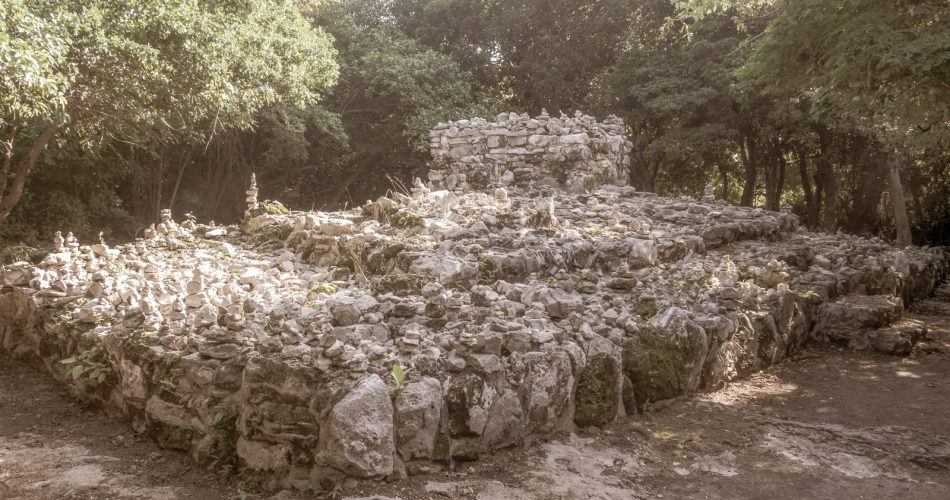In a groundbreaking discovery, an ancient Maya city, once hidden beneath dense jungle canopy in Campeche, Mexico, has surfaced not through a traditional archaeological dig but thanks to a digital search. With over 6,600 structures identified—ranging from modest homes to expansive courtyards, temples, and even sports fields—the city, now known as Valeriana, lay just minutes from a major road, veiled from modern eyes until recently.
Archaeologist Luke Auld-Thomas, while browsing through LiDAR data online, stumbled upon the clues that led to this historic find. The data, initially captured for carbon monitoring studies, held secrets of Maya civilization that had remained undetected in the rugged terrain of Campeche. The LiDAR (Light Detection and Ranging) technology uses laser pulses to create precise maps of land topography, which Auld-Thomas and his team from Tulane University and the Instituto Nacional de Antropología e Historia (INAH) utilized to locate Valeriana.
“Our analysis revealed not only the density of Maya settlements but also an unexpected variety,” Auld-Thomas said. “We didn’t just find rural villages but an entire city with monumental architecture right next to a modern highway.” This city likely peaked between 750 and 850 CE, potentially hosting 30,000 to 50,000 residents—population levels that suggest it could have been a Maya capital city.
A New Age of Archaeology
Historically, Maya cities were uncovered by archaeologists who meticulously hacked through jungles, searching for stone mounds hidden beneath foliage. In contrast, Auld-Thomas used a computer mouse, combing through online data to uncover structures that remained invisible to explorers on foot. This unexpected find marks one of the largest Maya settlements ever identified and provides a fresh perspective on the sheer size and complexity of Maya civilization.
As Auld-Thomas explains, LiDAR technology has revolutionized archaeological research, allowing scientists to survey vast, inaccessible areas from above. Originally, ecologists and engineers used the data for environmental purposes, but the study, which spanned a region larger than Connecticut, ended up revealing the remnants of an ancient society. This discovery underscores the vast potential of LiDAR in archaeology, prompting a rethink of what else could still be hidden beneath Central America’s jungles.
Ancient Metropolis Revealed
The Valeriana site encompasses an area of about 10 square miles, with remnants of pyramids, amphitheaters, reservoirs, and connecting pathways that reveal two major city centers linked by smaller settlements. This intricate network paints a picture of a densely populated, organized urban hub and challenges previous assumptions about Maya settlements. “Finding Valeriana was like opening a hidden chapter of history,” said Auld-Thomas. “It adds an exclamation point to the notion that the Maya lowlands are still brimming with undiscovered wonders.”
The discovery hints that additional large Maya cities may still lie undiscovered in the Mexican jungles, hidden under dense forest cover that LiDAR can now penetrate. This technology not only enhances archaeological research but also paves the way for exploring other ancient, uncharted territories.
A Window into Maya Society
The thriving metropolis of Valeriana, bustling with life over a thousand years ago, offers a rare glimpse into the socio-political landscape of Maya civilization. Unlike previously mapped settlements, this city’s proximity to modern infrastructure highlights a poignant contrast between ancient achievements and the lack of awareness about them until now. Valeriana’s presence may encourage renewed efforts in archaeology, combining advanced digital resources with traditional expertise to uncover more lost cities. “This discovery shows us that, despite all our advancements, there’s still much to learn about our past,” Auld-Thomas reflected. “The Maya civilization may have a lot more secrets waiting for us.”
This monumental find raises new questions and invites curiosity about the potential of technology in archaeology. What other ancient sites might remain undiscovered due to the limitations of traditional excavation methods? Could more extensive surveys across the Maya lowlands reveal cities yet untouched by modern knowledge? The Valeriana discovery is a testament to the blend of curiosity, technology, and research that continues to push the boundaries of human knowledge.

